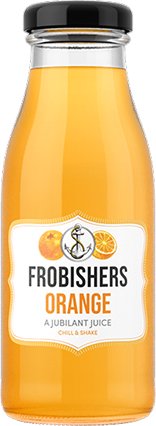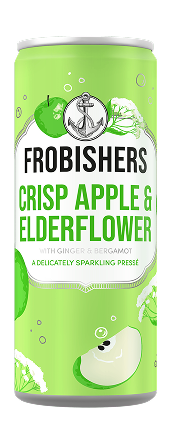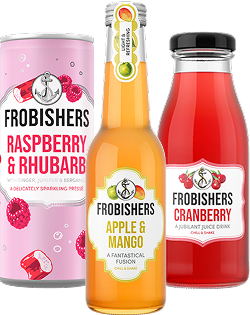Helping to Understand the Term Ultra-Processed Foods
✍️ Written by Becca Winmill, Frobishers Operations Manager
For many, the term ultra processed foods (UPFs) conjures thoughts of foods that are high in fat, sugar and salt e.g. mass-produced ready meals, cakes and other bakery products. However, a great many foods and daily supplements contain elements that fall into UPF cauterisation. Soft drinks are often blanketly categorised by the media as ultra-processed foods. This is largely because, unlike Frobishers, many popular fizzy drinks contain added elements, such as artificial flavours, colours, preservatives and sweeteners. If you read on, we hope to help explain where Frobishers’ products fit within this quite complex topic.
As yet, the UK has no universally agreed definition of UPFs, and different organisations often classify them in different ways. One emerging system that is gaining popularity is the NOVA classification, which groups food and drink based on how much processing they undergo.

Here's a quick breakdown of the four NOVA categories:
1. Unprocessed or minimally processed food: Fresh foods like fruits, veggies, milk, meat, and eggs. The only processing they go through is things like washing, peeling, freezing, or pasteurizing.
2. Processed culinary ingredients: Things like oils, butter, sugar, and salt that come from natural foods (like the ones in Group 1), but go through processes like pressing or grinding.
3. Processed foods: Foods that are still recognisable as their original form but have been altered by processing. For example, canned fruits and vegetables, cheese, homemade bread, or even beer and wine.
4. Ultra-processed foods: These are the ones with little to no whole food in them. They're usually packed with artificial additives and preservatives. Think things like packaged snacks, instant noodles, processed meats, and mass-produced baked goods.
What about fruit juices?

Not from concentrate (NFC) juices require limited processing when compared to juices made from juice concentrate. e.g. NFC juices are made by pressing juice from fruit then pasteurising it to keep it safe before packaging. Concentrated juices are made from NFC juices but with the addition of being subjected to a series of high temperature processes to remove the naturally occurring water within the juice. For clarity 100% pure juices are not considered ultra-processed, just minimally processed to ensure they’re safe to consume and to offer shelf life.
Some Frobishers products contain naturally occurring additives. For example, to help prevent apple juice from oxidising (going brown), our NFC apple juice has a dash of vitamin C added just after pressing the apples. This is where NOVA is perhaps ambiguous, but it’s possible to conclude the addition of vitamin C pushes our apple juice from a NOVA 1 classification to a NOVA 4 and therefore according to NOVA make them a UPF. In our view this is where the NOVA system fails as it could effectively place our apple juice in the same category as a bottle of diet cola containing aspartame, acesulfame K, caffeine flavouring, phosphoric acid and artificial colouring E150d; in our view hardly a fair comparison.
A transparent look at our ingredients
99.99% of the liquid in Frobishers bottles is either pure fruit juice or water. We’re all about transparency, and so we want to explain the 0.01% of other ingredients – what they are and why we use them.
· Ascorbic acid: an antioxidant, also known as Vitamin C. It is naturally present in many fruits. This is added at the pressing stage to prevent the juice turning brown too quickly. You’ll see it added to most major brands of NFC apple juice.
· Fructose: a simple sugar which occurs naturally in fruits. We add this to our Cranberry Juice Drink, as unsweetened cranberry juice would be very tart and unpalatable.
· Pectin: a stabiliser that is naturally present in most fruits; ours is derived from apples. The natural sediment in pineapple juice separates very quickly, and pectin helps to prevent this. We don’t add too much, so give your bottle a good shake before opening.
· Citric acid: this also occurs naturally in many fruits. We use it sparingly in some of our Sparklers and Pressés, sometimes with ascorbic acid, to balance flavour.
· Fruit derived sugar: you’ll see this on the ingredients list for our Mango, Cherry and Bumbleberry Juice Drinks. It’s concentrated grape juice, used to naturally sweeten our drinks. Other brands might label this as ‘fruit extract’ or ‘grape syrup’.
· Natural extracts and flavours: we sometimes use small amounts of these substances, derived from natural fruits and botanicals, to impart complexity and depth of flavour.
· Sugar: a few of our products do contain added sugar. We much prefer it to artificial sweeteners! For more information, you can read our Sugar & Fruit Juice: Frobishers FAQs.
Our commitment to honest labelling
One of the most trusting things we all consciously do every day is put food and drink into our bodies, therefore it is paramount that all product labelling is clear, accurate and understandable by our consumers. It’s worth noting that some drinks brands might use different words on their packaging, for example, vitamin C sounds nicer than ascorbic acid. We always use the proper legal names for our ingredients, and we always get Trading Standards to approve our product labelling to ensure we are never misleading our customers.
Having set out our position, we are always looking to improve, therefore we are currently reviewing some of our recipes to see if we can find a way to continue creating great tasting drinks while further minimising the need for some of the processed ingredient elements.
For those who like to understand more please take a look at the Advisory Committee for Social Science web site Background | Advisory Committee for Social Science which refers to NOVA classifications and quotes the following:
“It is noteworthy that these definitions of UPF are both complex and rather ‘fuzzy’, in that they include rather imprecise terms such as ‘mostly’, ‘multi’ and ‘series’. It might be expected, therefore, that consumers might struggle with the concept of UPFs and, even more, be unable to reliably differentiate between foods that do or do not fall into the category of UPFs”.
If you have any questions relating to the ingredients in our drinks, we’re always happy to discuss them with you. Please contact ahoy@frobishers.com who can put you in touch with Becca.








